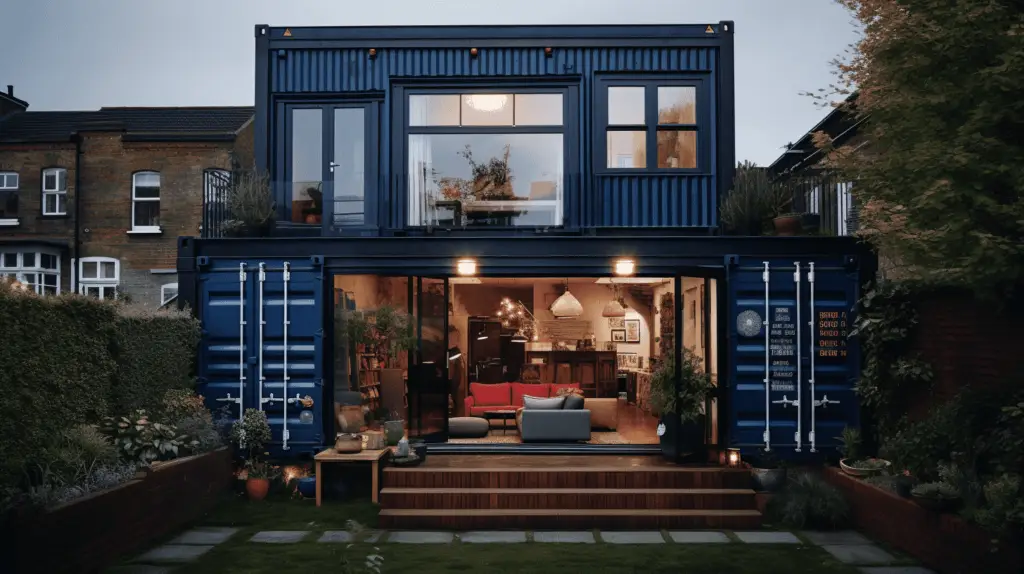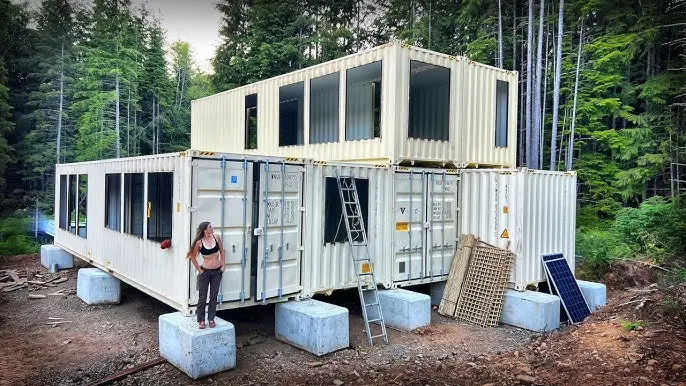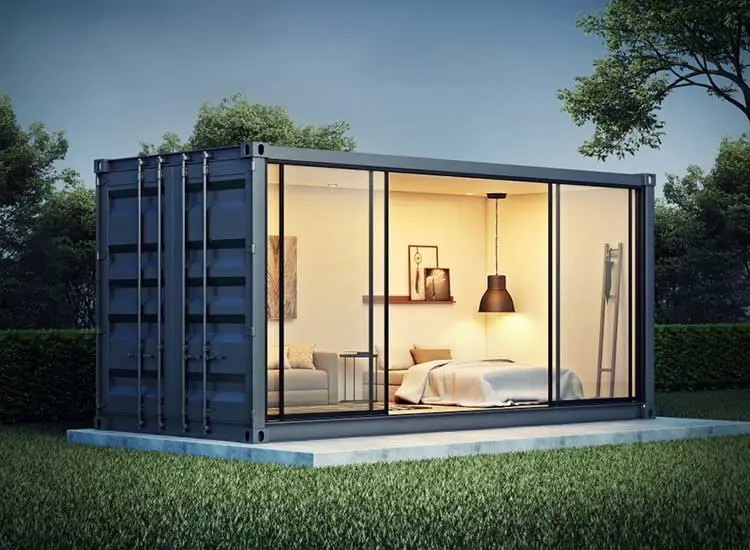Navigating Planning, Building Regulations and Design
The concept of turning a shipping container into a functional, stylish home has surged in popularity across the UK. With housing prices soaring, land becoming scarce, and a national push toward sustainability, these steel boxes—once used to transport goods across oceans—offer a creative, affordable alternative to traditional brick-and-mortar homes. But is it really practical to live in a repurposed container? Can you navigate the complex web of UK planning laws, building regulations, design challenges, and land acquisition to make it work? In this detailed guide, we’ll explore every aspect of building a shipping container home, providing you with the knowledge to decide if this innovative housing solution is right for you.
Why Choose a Shipping Container Home?
Shipping containers are more than just industrial relics; they’re robust, cost-effective, and surprisingly versatile. Typically available in standard sizes like 20ft (6m) or 40ft (12m) lengths, they’re built to endure harsh weather and heavy loads, making them a solid foundation for a home. In the UK, where sustainable living is increasingly prioritized, container homes appeal to eco-conscious individuals looking to reduce their carbon footprint. By repurposing a container, you’re recycling a resource that might otherwise rust away in a shipping yard—a small but meaningful step toward a greener future.
Beyond sustainability, the affordability factor is a major draw. A used shipping container can cost as little as £1,500 to £3,000, far less than the price of traditional building materials. Add in their modular nature—allowing you to stack, combine, or reconfigure them—and you’ve got a recipe for a customizable home that doesn’t break the bank. However, the journey from container to cozy dwelling involves more than just buying a box. Let’s dive into the practicalities, starting with the all-important question of planning permission.

Planning Permission: Do You Need It?
In the UK, planning permission is a critical hurdle for any unconventional construction project, and shipping container homes fall squarely into this category. Whether you need approval depends on several factors, including the container’s intended use, its location, and its permanence.
Temporary vs. Permanent Structures
If you’re placing a container on your property as a temporary structure—say, a movable office or storage unit—you might dodge the need for planning permission under permitted development rights. These rights allow certain minor developments without formal approval, provided they meet strict criteria (e.g., height limits of 2.5 meters and no permanent foundations). However, if you’re converting that container into a permanent residence, complete with plumbing, electricity, and a fixed foundation, you’ll almost certainly need to apply for permission from your local planning authority.
Location-Specific Rules
Where you place your container matters immensely. In an urban garden, you might squeak by under permitted development if the container serves an ancillary purpose (like a home office) and adheres to size restrictions. But in rural areas, especially designated zones like Areas of Outstanding Natural Beauty (AONB), National Parks, or conservation areas, the rules tighten. Local councils in these regions often prioritize preserving the landscape’s character, meaning a steel box might not be welcomed without a compelling case.
Change of Use Considerations
Transforming a shipping container into a livable home typically involves a “change of use” under planning law—from its original industrial purpose to residential. This shift triggers a need for formal approval, even on land you own. To improve your chances, prepare a strong application with detailed plans, emphasizing the project’s sustainability and minimal environmental impact.
Practical Steps
Start by contacting your local council’s planning department. Many offer pre-application advice services (sometimes for a small fee) to clarify whether your project is viable. Be ready to explain how your container home fits into the local development plan and addresses community concerns like aesthetics or traffic. Patience is key—planning applications can take 8-12 weeks, or longer if objections arise.
Building Regulations: Ensuring Safety and Compliance
Securing planning permission is just the first step; your shipping container home must also comply with UK building regulations. These legally enforceable standards ensure your home is safe, energy-efficient, and fit for habitation. Here’s what you’ll need to tackle:
Insulation and Energy Efficiency
Shipping containers are metal shells—great for durability, terrible for temperature control. Without insulation, they’re ovens in summer and iceboxes in winter. Part L of the Building Regulations mandates minimum thermal performance, so you’ll need to install high-quality insulation (e.g., spray foam or rigid panels) on walls, floors, and the roof. Double-glazed windows and proper ventilation are also essential to prevent condensation and meet energy efficiency targets.

Structural Integrity
Containers are strong, but modifying them—cutting holes for doors, windows, or to join multiple units—compromises their integrity. Part A requires that any alterations maintain structural stability. Consult a structural engineer to design reinforcements, such as steel beams or bracing, especially if you’re stacking containers or creating an open-plan interior.
Fire Safety
Fire resistance is non-negotiable under Part B. You’ll need fireproof cladding or linings (like gypsum board), adequate escape routes (e.g., multiple exits), and possibly smoke alarms or sprinklers, depending on the size and layout.
Utilities and Services
Plumbing, drainage, and electrical systems must comply with Parts G, H, and P. This means safe water supply, effective waste removal, and wiring that meets British Standards (BS 7671). If your land lacks utility connections, consider off-grid solutions like solar panels or composting toilets—common in rural container homes.
Approval Process
Submit detailed plans to your local building control office or an approved inspector. They’ll review your design and may conduct site visits during construction. Non-compliance can lead to costly fixes or even demolition, so hiring a professional with experience in modular homes is a smart investment.
Design Ideas: Making It Your Own
The beauty of shipping container homes lies in their adaptability. Whether you’re dreaming of a minimalist retreat or a sprawling family abode, the design possibilities are vast. Here are some ideas to spark your creativity:
Single-Container Simplicity
A single 20ft or 40ft container (offering 160 or 320 square feet, respectively) can become a sleek studio. Incorporate a compact kitchen, a fold-down bed, and a small bathroom with a wet room layout. Ideal for solo dwellers or couples, this setup maximizes space without sacrificing style.
Multi-Container Configurations
For more room, combine multiple containers. Arrange them side-by-side for a wider footprint or stack them for a two-story home. A popular design connects two 40ft containers with a central glass atrium, creating a bright, airy living area.
Sustainable Features
Boost your home’s eco-credentials with solar panels, a green roof planted with native species, or a rainwater harvesting system. These not only reduce your environmental impact but can also lower utility bills—a win-win in the UK’s unpredictable climate.
Aesthetic Enhancements
Soften the industrial vibe with wooden cladding, painted exteriors, or corten steel for a weathered look. Large windows or sliding glass doors flood the interior with light, while a rooftop deck adds outdoor living space.
Real-World Inspiration
Look to UK projects like Container City in London’s Trinity Buoy Wharf, where stacked containers form vibrant live-work spaces, or the rural container homes popping up in Devon and Cornwall. These prove that with imagination, containers can rival conventional homes in comfort and charm.
Finding Land in the UK
A container is only half the equation—you need somewhere to put it. Land availability, cost, and suitability vary across the UK, presenting both opportunities and challenges.
Urban Options
In cities like London, Birmingham, or Manchester, space is at a premium. Small infill plots or underused corners of commercial land might work, but expect high costs (£50,000+ for tiny parcels) and stringent planning rules. Negotiating with private landowners or councils for temporary use could be an option.

Rural Opportunities
Rural areas offer more bang for your buck. A half-acre plot in Wales or Scotland might cost between £5,000-£15,000 (Circa 2025) please do your own research into pricing, with fewer neighbors to object. However, check for utility access—remote sites may require off-grid solutions, adding to your budget.
Legal and Practical Checks
Confirm the land’s zoning (residential use is a must) and access rights. Flood risk, soil stability, and proximity to services like roads or schools also matter. Use platforms like Plotfinder, Zoopla, or UK Land Directory to scout options, and hire a solicitor to handle conveyancing and title checks.
Is It Worth It?
Building a shipping container home in the UK isn’t a quick fix for affordable housing. Costs can range from £20,000 for a basic single-container setup to £150,000+ (prices as of 2025, please do your own research) for a multi-unit design with land, utilities, and finishes. Unexpected expenses—like planning delays, engineering fees, or land preparation—can inflate the budget further.
Yet the rewards are compelling. You’ll gain a unique, sustainable home tailored to your vision, often at a lower cost per square foot than traditional builds. As of March 06, 2025, with the UK housing market still strained, container homes offer a viable path to ownership for those willing to invest time and effort.
Getting Started
Begin with research—consult your local council, hire an architect familiar with modular construction, and crunch the numbers. Visit existing container homes for firsthand insight, and join online communities (e.g., UK-based forums or X groups) to learn from others’ experiences. With persistence and planning, your shipping container dream could become a reality.
Shipping Containers: A Secure Storage Solution










